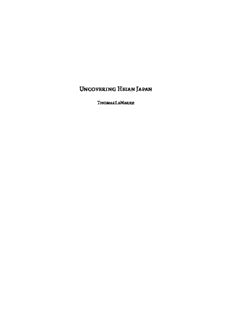
Uncovering Heian Japan: An Archaeology of Sensation and Inscription (Asia-Pacific: Culture, Politics, and Society) PDF
Preview Uncovering Heian Japan: An Archaeology of Sensation and Inscription (Asia-Pacific: Culture, Politics, and Society)
Uncovering Heian Japan Thomas LaMarre 8 4 2 f o 1 t e e h s / N A P A J N A I U H J E H G N I R E V O C N U / e r r a m a L 0 8 9 5 0 : T S D 7 4 : 6 1 4 1 . 2 1 . 0 0 0 2 g n e s T 8 4 2 f o 2 t e e h s / N A P A J N A I ASIA-PACIFIC E H G IN Culture,Politics,andSociety R E V CO Editors:ReyChow,H.D.Harootunian, N U / andMasaoMiyoshi e r r a m a L 0 8 9 5 0 : T S D 7 4 : 6 1 4 1 . 2 1 . 0 0 0 2 g n e s T 8 4 2 f o 3 t e e h s / N A P A J N U H J A I E H G N I R E V O AnArchaeologyofSensationandInscription C N U / e r r ma T LM a L 0 8 9 5 0 : T DS DukeUniversityPress DurhamandLondon 7 4 : 6 1 4 1 . 2 1 . 0 0 0 2 g n e s T 8 4 2 f o 4 t e e h s / N A P A J N A I E H G N I R E V O C N U / e r r a m a L 0 8 9 5 ©DukeUniversityPress Allrightsreserved PrintedintheUnitedStatesofAmericaonacid-freepaper) TypesetinQuadraatbyTsengInformationSystems,Inc. 0 T: LibraryofCongressCataloging-in-PublicationData S D appearonthelastprintedpageofthisbook. 7 4 : 6 1 4 1 . 2 1 . 0 0 0 2 g n e s T 8 4 2 f o 5 t e e h s / N A P A J N A I E H G N I R E V O C N U / e r r a m a L 0 8 9 5 Acknowledgments vii ANoteonTransliterationandIllustrations ix Introduction:UnstatingHeianJapan PARTONE.THEINTERPRETATIONOFREBUSES .RevisingtheRebus .KanaInscriptionandStylisticDifferentiation .CompositionandCompetition PARTTWO.INSCRIPTIONANDSENSATION .TowardaHistoryofStyles .HeianCalligraphy .TheMultisensibleFigure: AshideShita-eWakanrōeishō PARTTHREE.THESONGMACHINE .TwoPrefaces,TwoModesofAppearance .Tsurayuki’sSongMachine Notes WorksConsulted Illustrations Index 0 : T S D 7 4 : 6 1 4 1 . 2 1 . 0 0 0 2 g n e s T 8 4 2 f o 6 t e e h s / N A P A J N A I E H NG This Page Intentionally Left Blank I R E V O C N U / e r r a m a L 0 8 9 5 0 : T S D 7 4 : 6 1 4 1 . 2 1 . 0 0 0 2 g n e s T 8 4 2 f o 7 t e e h s / N A P A J N A I E H G N I R E V O C N U / e r r a m a L 0 8 9 5 Overthepasttenyears,thechaptersofthisbookhaveproliferatedasinsis- tentlyasHeianwakaandtheircommentaries,threateningtounfurlacross continentsanderaswithcountlessleavesofwords.Iwishtoexpressmy heartfeltthankstothosewhohavehelpedmehackbacktherankergrowth. Theresearchitselfseemedtooccupythelargerpartofmygraduateyears attheUniversityofChicago,whereNormaFieldinparticularguidedand encouragedmyeffortsateverystepalongtheway,fromteachingclassical JapanesetointroducingmetoJapanesescholars,andpatientlyandgener- ouslyreadingvariousdrafts.Moreover,Normaandtheothermembersof mycommittee,HarryHarootunian,MellieIvy,andBillSibley,didagreat deal to establish the critical trajectoryof this study, advising me to con- siderseriouslythequestionofthemediationoftraditionwithrespectto HeianJapananddirectingmyattentiontotheformationofmodernityin Japan.Iamdeeplyindebtedtothemfortheirintellectualcommitmentand encouragementovertheyears. Becauseofthecomplexityoftheproject,however,itwasonlyafterIhad completedadissertationdealingwithMeijiandTaishōJapanthatIwasable todevoteafullyear(–)inJapantofurtherresearch,undertheguid- anceofMitaniKuniaki,withoutwhoseexpertiseandenthusiasmIwould havebeenunabletosteermywaythroughthelabyrinthofclassicalscholar- ship. Narita Makoto and especiallyTsuzura Junji also contributed to the projectinvariousways. Thebulkofthisbookwascomposedduringayear(–)attheSo- ciety for the Humanities at Cornell University,where conversations with 0 : T other fellows and with members of the Cornell East Asia program had a S D 7 4 : 6 1 4 1 . 2 1 . 0 0 0 2 g n e s T 8 4 2 f o 8 t e e h s / profoundimpactonitsargumentsandpresentation.Iwishparticularlyto N A P express my thanks to Brett de Bary for her invaluable comments on this A J and other projects, to Naoki Sakai for continually taking time from his N A I ownworktoreadandcommentonthemanuscriptinprogress,andtoTim E H Murray,DavidRodowick,andothermembersoftheDeleuzestudygroup. G N I AtMcGillUniversity,KenDeanhasunstintinglyofferedemotionalsup- R E V port,intellectualencouragementandadministrativeassistance,andBrian O C UN Massumiarangeofinsightsandsuggestions.Moreover,Icouldnothave / completedthemanuscriptwithoutgrants,timereleases,andservicespro- e rr videdbytheFulbright-HayesFoundation,theSocialScienceandHumani- a m a ties Research Council of Canada, and Fonds pour la Formation de Cher- L 0 cheursetl’AideàlaRecherche. 8 9 5 Finally,specialthankstoChristineLaMarreforhersuperhumanefforts toholdZéroandMalineincheck,togetherwithEthanNasreddin-Longo andStuartSumida. 0 : T S D 7 4 : 6 1 4 1 . 2 1 . 0 0 0 2 g n e s T 8 4 2 f o 9 t e e h s / N A P A J N A I E H G N I R E V O C N U / e r r a m a L 0 8 9 5 AlthoughpinyinisthepreferredsystemofromanizationforChinese,be- cause all the English-language sources for this study employ the Wade- Gillessystem,Ihaveusedthelatterthroughout.Fortheromanizationof modernJapanese,IusetheHepburnsystem,withcertainstandardmodifi- cations.ForHeianJapanese,inordertoindicateitsdifferencesfrommod- ern Japanese, I use ti, tu, and si instead of chi, tsu, and shi. In addition, followingstandardpractice,IadheretothesyllablesofclassicalJapanese ratherthantransformingthemintomodernpronunciations:forexample, seuratherthanshō,andsoon.Whilesomescholarsalsomarkthehofha,hi, hu,andsoonwithanFinordertoindicatethedifferentpronunciationof theHeianh,Isimplyemployh.Forthemostpart,inthetextIusetheHeian transliterationforHeiantermssuchasomohuorwominahesi.Insomeother instancesthemoderntermissofamiliarthatIusemoderntranscription, notablywithawase(ratherthantheHeianahase). TransliterationofthepoemsofMan’yōshūisquitecomplex.Inthevery fewinstancesinwhichItransliteratewordsfromMan’yōpoems,IuseHeian transliterationtoavoidintroducingyetanothersystemoftransliteration. Since,innearlyallthesecases,IgivesomeversionoftheoriginalinChi- nesecharacters,thosewhoareconcernedwithphonetictransliterationcan refertotheoriginal.Inacouplepoemsitwasimpossibletoprovideallthe charactersoftheoriginal(becauseofthepaucityofcharactersinmyJapa- nesesoftware);theseraresubstitutionsoromissionsaredescribedinthe notes. Asregardsillustrations,therearenineexamplesofcalligraphyappended 0 : T tothetext,towhichIreferrepeatedly.Thisisastrategyintendedtoen- S D 7 4 : 6 1 4 1 . 2 1 . 0 0 0 2 g n e s T
Description: